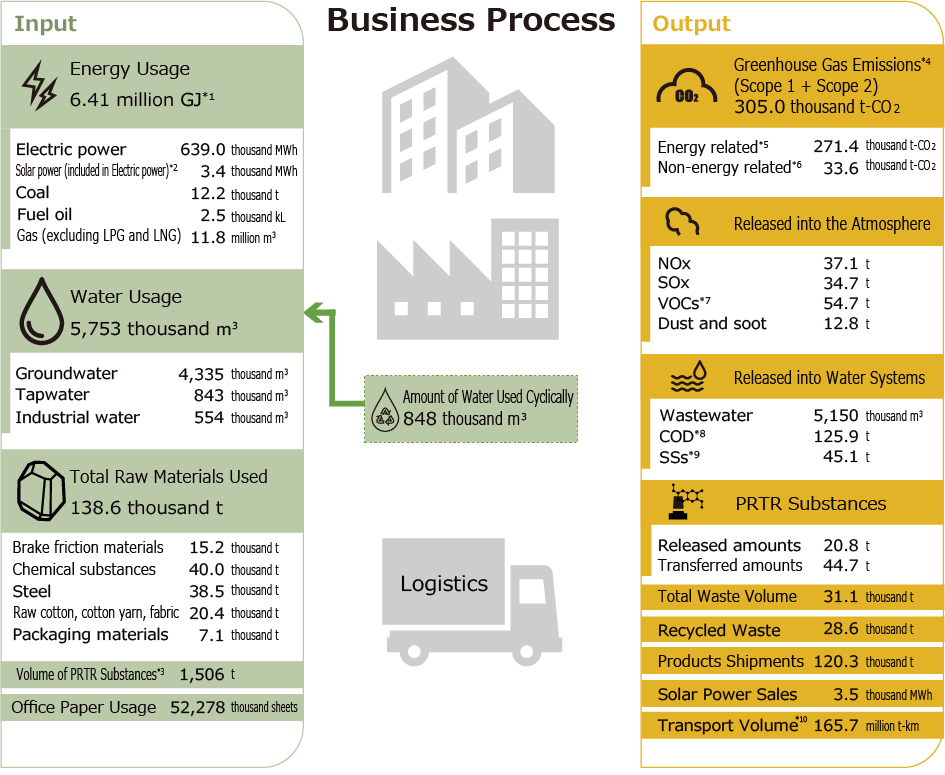The table below shows the Nisshinbo Group’s business activities and environmental impact.Environmental data sheets for principal subsidiaries are also published.

[Subject Organizations]
On November 28, 2024, the Company included ARGONICS GmbH and ARGONAV GmbH within the scope of consolidation as subsidiaries in the Wireless and Communications business. However, data for these companies is not included in the FY2024 data. The data collection for FY2024 covers 86 companies, excluding ARGONICS GmbH and ARGONAV GmbH.
*1 Gigajoule (GJ): A unit of energy measurement. 1GJ=109J=about 240,000 kilocalories
*2 Not including electricity sold under the feed-in tariffs scheme for renewable energy
*3 PRTR substances: Substances subject to the Pollutant Release and Transfer Register (PRTR) system pursuant to the "Act on the Confirmation, etc. of Release Amounts of Specific Chemical Substances in the Environment and Promotion of Improvements to the Management Thereof" and reports of their amounts of release and transfer must be filed.
*4 Greenhouse gases emissions are reported after applying carbon credits. Nisshinbo Automotive Manufacturing Inc. (USA) purchased carbon credits and offset 2.9 thousand t-CO2e. Calculation Method is below:
- ・Scope1:
-
- Energy-related Greenhouse Gas Emissions = Σ [Fuel Consumption × CO2 Emission Factor*4-1]
- Non-Energy-related Greenhouse Gas Emissions = Non-Energy-related CO2 Emissions + Σ [Greenhouse Gas Emissions other than CO2 × Global warming potential*4-2]
-
- *4-1 Emission factors based on the Act on Promotion of Global Warming Countermeasures are used. Coal, however, uses a factor calculated based on actual calorific values, which is 1.870 t-CO2/t in FY2024.
- *4-2 Global warming potential based on the Act on Promotion of Global Warming Countermeasures.
- *4-1 Emission factors based on the Act on Promotion of Global Warming Countermeasures are used. Coal, however, uses a factor calculated based on actual calorific values, which is 1.870 t-CO2/t in FY2024.
- Energy-related Greenhouse Gas Emissions = Σ [Fuel Consumption × CO2 Emission Factor*4-1]
- ・Scope2:
-
- Energy-related GHG emissions = Σ [purchased electricity and purchased steam volume × CO2 emission factor*4-3]
-
- *4-3 Purchased electricity uses, in Japan, adjusted emission factors for each electric company based on the Act on Promotion of Global Warming Countermeasures in Japan, and the in foreign countries, the emission factors for each electric company, and if unavailable, country-specific emission factors published for the year in question from "IEA Emissions Factors" are used. Purchased steam uses an emission factor calculated by the purchasing company (0.0526 t-CO2/GJ in FY2024).
*5 Energy-derived greenhouse gas emissions: Greenhouse gas emissions due to fuel consumption
*6 Non-energy derived greenhouse gas emissions: Greenhouse gas emissions due to reasons other than fuel consumption, e.g. manufacturing process, waste products, etc
*7 Volatile Organic Compounds (VOCs): Emissions of volatile organic compounds such as toluene
*8 Chemical Oxygen Demand (COD): Chemical Oxygen Demand, or Chemical Oxygen Consumption, is an indicator that shows water contamination levels
*9 Suspended Solids (SSs): The amount of foreign substances floating in water
*10 Transportation volume: Total of land, sea, and air transport volumes
Please refer to “Environmental Data” for details on our environmental data.

